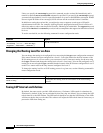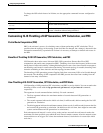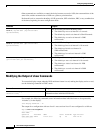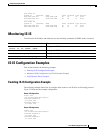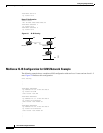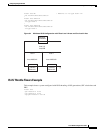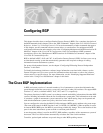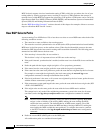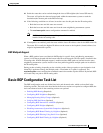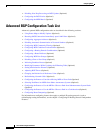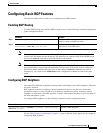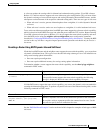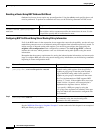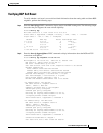
Configuring BGP
The Cisco BGP Implementation
IPC-294
Cisco IOS IP Configuration Guide
BGP Version 4 supports classless interdomain routing (CIDR), which lets you reduce the size of your
routing tables by creating aggregate routes, resulting in supernets. CIDR eliminates the concept of
network classes within BGP and supports the advertising of IP prefixes. CIDR routes can be carried by
Open Shortest Path First (OSPF), Enhanced IGRP (EIGRP), and Intermediate System-to-Intermediate
System (ISIS)-IP, and Routing Information Protocol (RIP).
See the “BGP Route Map Examples” section at the end of this chapter for examples of how to use route
maps to redistribute BGP Version 4 routes.
How BGP Selects Paths
A router running Cisco IOS Release 12.0 or later does not select or use an iBGP route unless both of the
following conditions are true:
• The router has a route available to the next hop router:
• The router has received synchronization via an IGP (unless IGP synchronization has been disabled).
BGP bases its decision process on the attribute values. When faced with multiple routes to the same
destination, BGP chooses the best route for routing traffic toward the destination. The following process
summarizes how BGP chooses the best route.
1. If the next hop is inaccessible, do not consider it.
This decision is why it is important to have an IGP route to the next hop.
2. If the path is internal, synchronization is enabled, and the route is not in the IGP, do not consider the
route.
3. Prefer the path with the largest weight (weight is a Cisco proprietary parameter).
4. If the routes have the same weight, prefer the route with the largest local preference.
5. If the routes have the same local preference, prefer the route that was originated by the local router.
For example, a route might be originated by the local router using the network bgp router
configuration command, or through redistribution from an IGP.
6. If the local preference is the same, or if no route was originated by the local router, prefer the route
with the shortest autonomous system path.
7. If the autonomous system path length is the same, prefer the route with the lowest origin code (IGP
< EGP < INCOMPLETE).
8. If the origin codes are the same, prefer the route with the lowest MED metric attribute.
This comparison is only made if the neighboring autonomous system is the same for all routes
considered, unless the bgp always-compare-med router configuration command is enabled.
Note The most recent Internet Engineering Task Force (IETF) decision regarding BGP MED
assigns a value of infinity to the missing MED, making the route lacking the MED
variable the least preferred. The default behavior of BGP routers running Cisco IOS
software is to treat routes without the MED attribute as having a MED of 0, making the
route lacking the MED variable the most preferred. To configure the router to conform
to the IETF standard, use the bgp bestpath med missing-as-worst router configuration
command.
9. Prefer the external BGP (eBGP) path over the iBGP path.
All confederation paths are considered internal paths.



